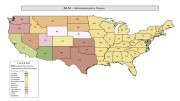The last month has seen a shift in oil prices, and with it, our industry has started to react. Now more than ever, reducing cost while becoming more efficient at what we do is a key goal moving forward. Oil and gas companies will be looking to improve processes while reducing waste. Like it or not, previous ways of doing business are going to be analyzed, with innovations in technology more important than ever.
In our world, this means reviewing expensive, long term subscriptions of data that might need justification. Are they adding value and maximizing revenue?
So, you ask, what is your point?
This is more like it
Apart from a few exceptions (like private fee leases and pre-1976 wells in Texas), more often than not, well data, land grid data and culture data all come from the same sources – regardless of the vendor.
Well data tends to be collected from the state (like US Land Grid – however, to be fair, some vendors have gone to individual county courthouses to improve historic and missing state reported well data). A good way to check the accuracy of well spots is by streaming in imagery into your application (US Land Grid can help with this).
Land grid data is sourced from the USGS 1:24k topos in the PLSS states. It’s easy to check the accuracy of completeness of this grid by streaming in the USGS topo map into your mapping application. Texas is a little different. Texas land grid data is sourced from the Railroad Commission, the General Land Office or both. Most data vendors then clean and modify from that source. For example, we have modified our Texas land grid to fit the imagery wherever possible. Although this is arguable, we think streaming imagery is the best way to check the accuracy of your land grid in Texas.
So, back to the original point…
Are you checking the data quality based on the original source of that data? Are there other offerings that give you that same accuracy and content? Can you justify the amount of money you are spending compared to other offerings in the market that might save you money? Do you know what data subscriptions are going to auto-renew? Are you paying for data that you already have? Maybe more importantly… Are you a creature of habit who is scared of change?
Are you prepared to answer these questions?
As managers of spatial data, current market influences call for improved processes and reduced cost. Saving money without sacrificing quality or content will be a key focus.
We believe this is an opportunity for all of us to get smarter and better at what we do.
We want to be that partner that helps you get there.
Depending on your current data vendor, we can save you up to 10x of what you are currently paying for your oil and gas data (land grid data, well data, tax parcel data and cultural data).
We stand by our accuracy and offer a money back guarantee.
We don’t auto-renew our customers or have yearly leases or rentals. Our data never needs to be removed and is yours to keep and modify as needed.
We use new technologies to provide all users and mapping applications the data they need with instant delivery and multiple format types.
Our support is second to none with expertise in the main oil and gas mapping applications.
Find out more here – http://www.uslandgrid.com






Be the first to comment on "Economic influences on GIS data"